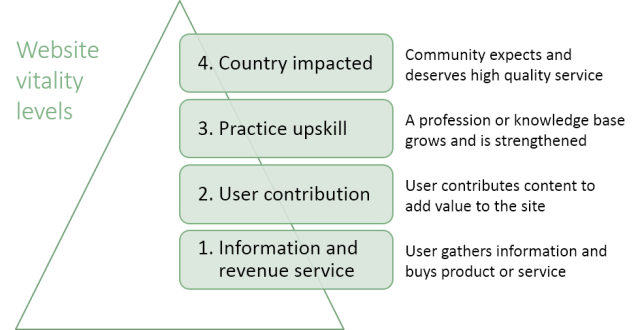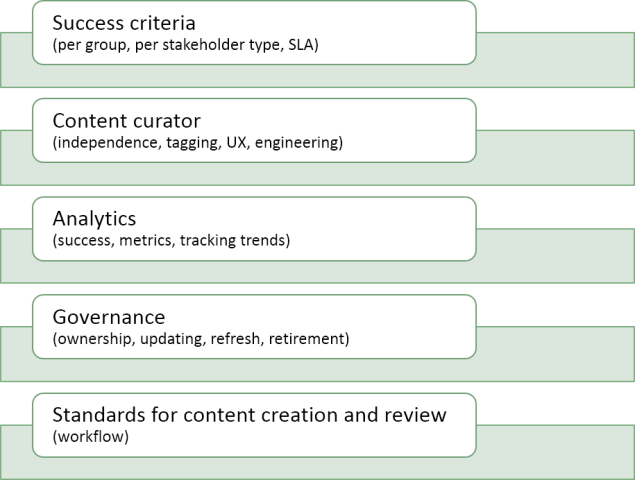
You look at your website and you’re tired of it. Maybe you’re thinking the site should be attracting more traffic or creating more leads.
Normally, people would think about outsourcing the revamping of a website or a surgical approach focused on search engine optimisation.
Yet some will think about a strategic approach, if they are looking to improve the digital maturity of their organisation, as they know this will enable future business transformation.
Let’s take a quick look at each of these approaches.
Outsourcing approach
Outsourcing your website revamp means handing it over to a website development company. This lets them do all the work and what you end up with will depend on the skills and foresight of that company.
There are good web development companies out there that will revamp and spruce up your website for you. Your site will be given a fresh look – more modern, flashy or based on specifications you have given.
But there are disadvantages of handing over all responsibility to someone else. The outcome may not necessarily meet the needs of your organisation nor result in improved user experience (UX). It will all depend on the skills and experience of the website development company.
Will they focus on web strategy and improving your digital presence overall? Or will they simply focus on graphic design? You’ll need to evaluate them carefully before making a decision.
If you want an approach that is straightforward and surgical, with a predictable outcome, it is probably better to look at a more tactical approach.
Search engine optimisation approach
Tactically, you could focus on how to exploit search engine optimisation (SEO), ensuring search results find more of your website content and send more traffic your way.
There are excellent articles and blogs on the internet that provide very helpful guidance on optimising your website to enable SEO.
For instance, Entrepreneur suggests improving SEO results by focusing on keywords, image tags, back-links and Meta descriptions. Kim Garst provides subtle but important guidance for achieving high ranks in search results by attending to the following:
- Using header tags to show what the content is about
- Focusing on writing longer content
- Using a variety of relevant words in content
- Making your site more mobile friendly
- Using lists and interactive elements to structure your content.
Due to an increase in mobile usage and newer search algorithms, SEO itself will evolve.
For instance, Copyblogger shows that with Google’s Hummingbird algorithm, keyword searching is likely to become less important as the growth in conversational speech searching evolves. Semantic analysis of search patterns becomes more viable and relevant. Such algorithms will impact the way web content is curated.
Optimisation-based tactical improvements can provide some quick wins for your website. But if you really want to mature the site in terms of how it impacts the business, and enable future business transformation, then taking a strategic approach can garner more impressive wins.
Maturing your digital strategy approach
Strategically, you could focus on the digital maturity of your organisation. That is, examine your website (and related communication channels such as social media and mailing lists) from the perspective of enabling the transformation of the business. You can use a structured approach to decide what should be done to revamp the site (and surreptitiously, help transform your business).
Let’s assume you have an existing website with thousands of web pages and thousands of visitors a month. You want to improve the site but you’re not sure how to approach it. And the sound of anything ‘strategic’ is a bit scary.
You wouldn’t mind outsourcing the work, but the underlying agenda of your organisation is to improve its digital maturity. And you know that strategy is the right avenue to take in transforming your business, rather than just focusing on technologies and the aesthetics of your website.
Having decided to focus on digital maturity, your organisation needs to do some work on its digital strategy even before it decides to outsource changes for the website. You can do this in a structured and easy manner, with typical steps for doing so shown in the table below. These are the questions that need to be answered at each step, along with related activities, outcomes you need to achieve and examples of such outcomes.
| Step | Question to be answered | Activity | Outcome | Example |
|---|---|---|---|---|
| 1 | What types of users really use my website and why? | Classify the types of users and their perspective and rationale for using the site. Know thy user! | Categorisation of user types and perspectives | 30 types identified along with descriptions of their interests/needs |
| 2 | What do the users really think of the website? | Survey each type of user including internal staff and external users. Often opinions are quite different internally versus externally | Results and analysis of different user types | Staff love the site but external users can’t find what they need |
| 3 | What could be added to the website that adds value for the user? | In the survey, ask each user type what ‘value of the website’ means to them | Variety of value statements | Staff say the latest technologies would add value whilst external users don’t want their time wasted having to read content not relevant to them |
| 4 | How vital is the website to the organisation’s mission? | Objectively evaluate the role your website plays on the ‘mission criticalness’ or vitality scale shown in Figure 1 | Vitality level recognised | Website is Level 4 vitality so it is vital to the health and well-being of this country |
| 5 | What is the goal of the website revamping or refresh? | Examine the options: for instance,
|
Goal chosen that will reflect the nature of changes to be made to website | The website wants to get more traffic from all 30 types of users. This means its capabilities must be broadened to support those types |
| 6 | What changes are needed to the site? | Discover and document the requirements for the changes | A documented set of requirements | The goal is to increase traffic for a particular type of user. That means the site will need to provide a ‘my home’ and a login capability with locked content |
| 7 | How should all the channels be aligned? | Determine how traffic arrives at the website and on which pages. For example, is it by a Google Search or by a link sent in an email or via a tweet? | Evidence about the channels of traffic, its origination and landing pages | Most traffic comes from a Google Search onto a particular content page rather than via the home page; so home page doesn’t really matter; Search does |
| 8 | What are the guiding principles for the website? | Decide upon the guiding principles by which decisions are to be made about the site and its content. Then audit your website against those principles – how well does it comply? | Four guiding principles will be used as the benchmark for every change made to the site. The compliance rating tells the company how close its website goals are achieved |
|
| 9 | How can we sustain a successful website? | Implement a web Success framework. Such a framework is described in Figure 2 | Description of the framework and who will manage it | A new Content Curator will be responsible for the framework |
Silicon Republic provides further details about what a digitally transformed business can look like.
Website vitality levels
Most websites are a vital part of a business, since they garner revenue from its users via product and service sales. But websites can play bigger roles for a company, its users, a country and the world. Figure 1 shows typical vitality levels that a website can aspire to become.

Figure 1. Website vitality levels
Understanding the vitality level of your website can impact the kind of ‘respect’ that it’s shown internally and externally – respect in the sense that it deserves a certain kind of budget, partnering, resourcing and such that reflects its degree of importance. Websites are often under-resourced or over-resourced compared to their vitality level.
Information and revenue service
Most websites are, generally speaking, vitality level 1 since the focus is selling.
User contribution
A level 2 example would be a website devoted to software viruses and people around the world contributing their experiences and evidence of viruses which in turn adds content and importance to that site.
Practice upskill
A level 3 example would be a site devoted to a nursing or doctor association that is geared to improving the practice of nursing and medical professions.
Country impacted
A level 4 site would be one devoted to world health and epidemic management to ensure a country is kept alerted to, and safe from, diseases and epidemics.
Web design and user experience
A successful website is informed by the company’s digital strategy. Good UX design of the website and content ensures that users have a great experience regardless of which platform is used (a PC or a mobile device). It ensures that users visit the site for longer and recommend it to others.
The content of the website itself is just as important as the look and feel of the site. Typically we recommend a Content Curator to oversee the nature of the content, as described below.
From a design perspective of the layout and navigation structure, a great website needs a good web designer, SEO and an excellent UX designer. Silicon Republic says that a website is like a maze.
The web designer builds the maze, while the UX designer guides the user through it.
A UX designer focuses on visual design elements, such as infographics, and maximises the ‘find capability’ of content on your site. The UX designer looks at interface behaviour and maximising the site’s usability and accessibility. Further details about UX design is given by Silicon Republic.
Often a UX designer will develop user journey maps to help design the site. The maps are a visual representation of each path that a user (type) can take in accessing information they need.
For instance, a website with different types of members will only want to access certain types of information and services. The interface is designed around that journey resulting in a website that is reflective of that type of user’s anticipated behaviour. This makes for a more intuitive experience for that type of user. Techtarget gives more details about journey maps here.
Frame uses journey maps for its various consulting activities. Those maps are especially useful when we want to improve complex processes for companies and fine tune decision making around customer scenarios.
Web success framework
Whether you have an IT team in-house to design, implement, maintain and support your website or you outsource it all, you still need some sort of web success framework. That is, you need a foundation for ensuring that your website is maintained and meeting your evolving business goals.
To enable this, Frame help companies set up a web success framework. The framework consists of the aspects illustrated in Figure 2 and explained as follows.
Success criteria
You’ll need to define criteria that shows whether your website has been successful or not – just because people visit the site, that doesn’t make it successful from a business perspective. Use the criteria as an annual benchmark for website progress. The criteria should be a combination of internal business goals as well as UX goals. Some examples could be:
- The audit of the content against the guiding principles improves by 10% each year
- Website is a candidate for an award each year
- Three business trends are tracked
- Feedback buttons show an improvement in customer experience
- Increase in revenue by X% for certain products
- Capture seven online poll results
- 10% annual reduction in ‘dead’ content.
Content curation
As in a museum full of different artefacts, large websites have many pages and types of content that need curation to assist in a better UX. A Content Curator can take ownership for this and can assume responsibilities for maintaining the UX to a high-level. The Curator can serve an independent role in a company especially when content comes from all departments of an organisation.
Formatting, tone, style and customer journeys can be aligned across the website. Standards can be implemented along with quality assurance practices. The Curator will ensure that the guiding principles are met by each change to the website as well as the implementation of sound engineering practices (such as configuration management of content). Social media channels can be aligned with the site as well as the company’s public relations approach (Wired provides some insights).
Analytics
Usage and performance data are needed to validate success criteria. Different departments may need different metrics by which to monitor the site (such as their events) and some may need data in real-time. Personal dashboards are often useful for monitoring key metrics and trends across a company.
Governance
Who owns the website and the content are always major issues in companies. Ownership needs tracking along with when content needs updating or needs retirement from the site. Often a governance council can guide the Content Curator on these matters and related policies.
Standards
Flexible standards, policies and processes are needed to ensure that content complies with the business formats and guiding principles of the website. Often, compliance workflow and quality assurance practices can be automated to ensure website changes are in alignment with the business and the goals for great UX.

Figure 2. Web success framework
Conclusion
There are various aspects to having a good company website. Those important aspects relate to guiding principles, content curation, UX (user experience) design and search optimisation.
Essentially you need to have a site that is easy to use, garners significant traffic via search engine results, meets your business goals and provides an enchanting user experience.
A website needs, as its foundation, guiding principles to ensure it doesn’t become a dumping ground for everybody’s content based on any whim. The principles will guide the decisions made for the website and its content. Also, there is a need to respect the nature (vitality) of the site and balance the goals of the business and the user experience against that.
A revamp of your website can also be used as an opportunity to focus on the digital maturity of your organisation as well as setting the groundwork for business transformation.











